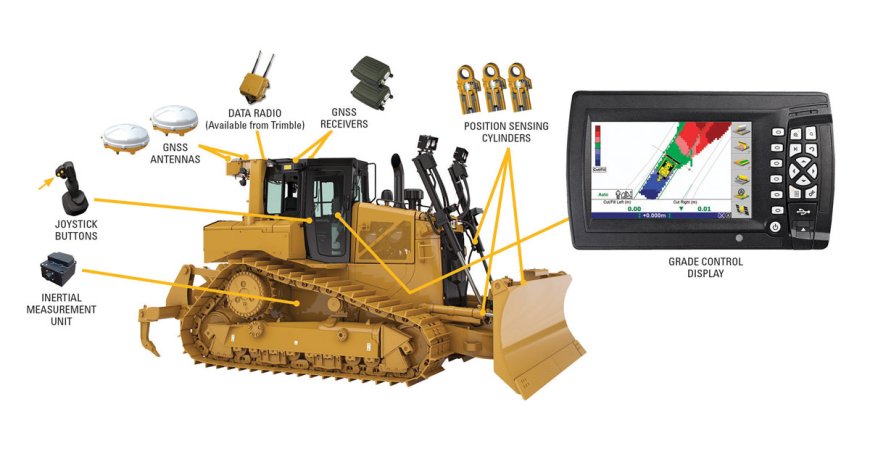MACHINE CONTROL TECHNOLOGY: Revolutionizing Precision and Efficiency

The construction industry has seen remarkable technological advancements over the past decade, and Machine Control Technology (MCT) stands at the forefront of this transformation. As construction projects become increasingly complex and demand higher precision, MCT products have emerged as critical components, enhancing automation, control, and overall efficiency on job sites. This feature finds the various types of automation and control solutions available, provides an overview of product ranges, explores technical specifications, and highlights the importance of training, support services, and data management.
In the ever-evolving world of construction, precision and efficiency are not just goals—they are necessities. As projects grow in scale and complexity, the need for advanced solutions to manage and control construction equipment has never been more critical. Enter Machine Control Technology (MCT), a game-changer that is redefining how construction tasks are executed with unparalleled accuracy and automation. MCT products integrate cutting-edge technology to enhance the capabilities of machinery, streamline operations, and drive productivity to new heights. From satellite-guided grading to laser-precision alignment, these systems are revolutionizing the construction landscape, ensuring projects are completed on time and within budget.
Types of Automation and Control Solutions…
Global Navigation Satellite System (GNSS) Control: GNSS-based systems utilize satellite signals to determine precise location data. These systems are widely used in grading, excavating, and other earth-moving operations. GNSS control allows for real-time adjustments and high accuracy, ensuring that machinery operates within specified parameters, thus reducing manual corrections and rework.
Laser Guidance Systems: Laser guidance technology uses laser beams to provide high-precision measurements and control. This system is especially effective in leveling, alignment, and grading tasks. By projecting a laser beam onto a target, operators can ensure that their equipment adheres to design specifications with minimal deviation.
Machine Control and Guidance Systems: These systems integrate sensors and software to provide real-time feedback to operators. They are used for tasks such as digging, grading, and paving. Machine control systems can automate functions like blade or bucket positioning, enhancing both accuracy and productivity. Features often include automatic grade control, slope control, and real-time data display.
Telematics Systems: Telematics integrates telecommunications and monitoring technologies to gather data from construction equipment remotely. This technology provides insights into machine performance, location, and usage, enabling predictive maintenance and operational optimization. It supports remote diagnostics and troubleshooting, enhancing the overall efficiency of fleet management.
Technical Specifications…
Accuracy and Precision
GNSS Systems: Typically offer centimeter-level accuracy, crucial for high-precision tasks.
Laser Systems: Can achieve accuracy within a few millimeters, ideal for detailed alignment and grading.
Machine Control Systems: Precision varies but generally provides millimeter-level control, essential for tasks requiring exact specifications.
Compatibility
Sensors and Controllers: Must be compatible with existing equipment and integrate seamlessly with various machine types.
Software: Often includes user-friendly interfaces and supports integration with other project management tools.
Durability
Products are designed to withstand harsh construction environments, including dust, moisture, and vibrations. High-quality materials and components ensure long-term reliability and reduced maintenance needs.
Training and Support Services
Effective implementation of Machine Control Technology requires comprehensive training and robust support services.
There is hands-on training conducted by manufacturers or certified trainers, focusing on system operation, maintenance, and troubleshooting. Online Resources including tutorials, videos, and manuals accessible through manufacturer websites.
Machine Control Technology products represent a significant leap forward in construction equipment, offering enhanced precision, automation, and efficiency. From GNSS and laser systems to telematics and machine control, these technologies provide a comprehensive suite of solutions for modern construction challenges. The integration of robust training, support services, and data analysis further amplifies their benefits, ensuring that construction projects can meet the demands of today’s fast-paced and precision-driven industry. As technology continues to advance, MCT products will remain a pivotal element in shaping the future of construction.
Future…
As the construction industry continues to embrace digital transformation, the future of Machine Control Technology (MCT) looks promising, with innovations set to further revolutionize how construction projects are executed. The evolution of MCT will not only enhance precision and efficiency but also drive sustainability, safety, and data-driven decision-making across the industry.
The future will see a shift from semi-automated to fully autonomous construction machinery. Equipment like excavators, dozers, and pavers will operate with minimal human intervention, using advanced sensors, artificial intelligence, and machine learning to perform complex tasks with unmatched precision. The concept of multiple autonomous machines working in unison, like a swarm, will become a reality. This will enable large-scale projects to be completed faster and more efficiently, as machines communicate and coordinate their actions in real-time.
AR will be integrated into MCT systems, allowing operators to visualize construction plans and machine controls in real-time through AR displays. This will improve accuracy and reduce errors during complex tasks. Virtual reality will revolutionize training for MCT, providing immersive simulations that allow operators to practice on virtual construction sites. This will enhance skill development and reduce the risks associated with training on actual equipment.
The industry will move towards global standardization of MCT systems, ensuring compatibility and interoperability across different manufacturers and regions. This will make it easier for construction companies to adopt and integrate MCT solutions, regardless of their existing equipment.
The development of open-source platforms for MCT will encourage innovation and collaboration within the industry. These platforms will allow for the customization and scaling of MCT solutions to meet specific project needs.








